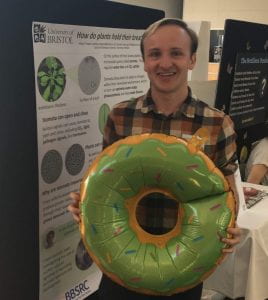 Stomata are microscopic pores found mainly on the leaves of plants that are key to plant survival. They open and close in response to a myriad of environmental signals and allow plants to regulate the flow of gasses into and out of leaf tissue. By controlling gas exchange stomata can influence the uptake of CO2, fuelling photosynthesis, and the loss of water, preventing dehydration. Our research investigates the mechanisms behind dark-induced stomatal closure.
Stomata are microscopic pores found mainly on the leaves of plants that are key to plant survival. They open and close in response to a myriad of environmental signals and allow plants to regulate the flow of gasses into and out of leaf tissue. By controlling gas exchange stomata can influence the uptake of CO2, fuelling photosynthesis, and the loss of water, preventing dehydration. Our research investigates the mechanisms behind dark-induced stomatal closure.
Much is known about the molecular mechanisms behind the drought hormone abscisic acid (ABA) induced stomatal closure. This is a response that allows plants to close their stomata and restrict waterloss under drought conditions. However, much less is known about the mechanisms behind-dark induced stomatal closure, a key response that prevents excessive waterloss at night. Previous research suggests that the cellular machinery responsible for ABA production and signalling may be playing a role in dark-induced stomatal closure, however the exact nature of this role is unclear. In this research we investigate the role of ABA metabolism and ABA signalling in dark-induced stomatal closure.
We find that plant mutants with defective ABA metabolism and signalling machinery have stomata that are still able to close in response to darkness, however, the speed of stomatal movements in these mutants is reduced. These findings show ABA signalling and metabolism are not essential for dark-induced stomatal closure and highlight that we still have a lot to uncover regarding the mechanisms behind dark-induced stomatal closure. They also identify ABA signalling and metabolism as potential targets for manipulating the speed of stomatal responses, a trait that has been shown to have significant impact on plant growth and water usage.
Ashley Pridgeon, SWBio DTP student
Paper: ABA signalling and metabolism are not essential for dark-induced stomatal closure but affect response speed by Ashley J. Pridgeon and Alistair M. Hetherington in Scientific Reports.
